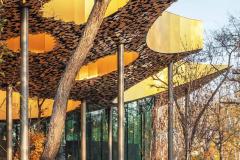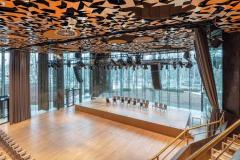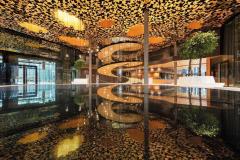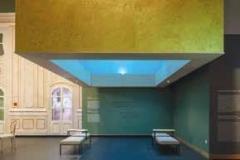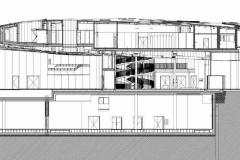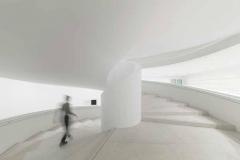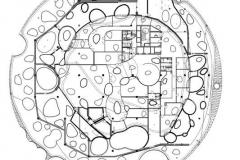A Moulded Building Sculpture
The House of Music, Hungary, Budapest
Architect: Sou Fujimoto
Text: György Szegő
Photos: Tamás Bujnovszky
Out of the 168 entries submitted for the international contest for the designs of the House of Music the one now actually realized excelled with its philosophy eliminating the borders between the natural and artificial environment. The Budapest project had to create a functional architecture with utmost respect to its green context which is a protected natural environment. This is exactly what Fujimoto has been specialized in by now. Adjusting to the strict framework of Liget project, he designed the House of Hungarian Music by keeping the above-ground upper three storeys of the five-storey structure beneath the foliage level of the parkland surrounding it. The multi-functional structure doubling as a museum and concert hall is surrounded by entirely transparent large expanses of glazed panels. The upper two storeys are supported by almost invisible slender steel columns. The reception space and the foyer of smaller and larger concert halls are covered with composite „foliages” from where the shop, a restaurant, the cloakroom and the toilets are accessible, and a breathtakingly lightweight and airy spiral staircase takes us up to the top levels. The larger concert hall on the ground-floor has a seating capacity of 320 people, and is equipped with a special machinery to convert it with an elevating auditorium. The lesser hall seats 80-120 people with concert and educational functions. The upper two storeys are pierced by a total of 100 ligh shafts with individual design, with some of them suited to let in natural light in the rooms. Whilst the terrain level is reserved for the performing arts, the spaces closed from natural light house a „dreamworld” in line with the concept of the house: here are the rooms for temporary and permanent exhibitions as well as a „sound-dome” which reflects a unique concept.
Client: Szépművészeti Múzeum, Városliget Ltd.
Leading architect: Sou Fujimoto – Sou Fujimoto Architects Inc.
Project team: Sou Fujimoto, Shintaro Honma, Marie de France, Yibei Liu, Roberto Sanz Asensio, Rugved Rane, Jacopo Todisco, Duc Ngo, Nicolas Gustin
Local partner in architecture: Tamás Noll – M-Teampannon Kft.
Architect of record: Bence Varga
Project architects: Norbert Nagy, Hajnal Dobos, Andrea Szabó, Zsófia Szűcs
Acoustics: Keiji Oguchi, Kosuke Suzuki, Nobuhiko Hattori – Nagata Acoustics Inc.; Arató & Józsa
Lighting: Sirius Lighting
Interiors: Sou Fujimoto Architects; Rózsa Csavarga, Szabolcs Bence Török, Szandra Szentgyörgyi– Sandroza Ltd.
Structure: István Kenese – Kenese Mérnöki Iroda Ltd.
Steel structure: Balázs Puskás – Terraplan
Parametric steel structure: András Balázs Kocsis – Kész Group
Civil engineering: Csaba Petik – Petik Kft.
HVAC: András Lantos, Sándor Dévényi, Pál Darabos – Lanterv Mérnöki Iroda Ltd., László Kolarovszki, Balázs Nyári, Péter Tibold, János Áy – Körös Consult Ltd.
Electrical engineering: Ferenc Rajkai, Péter Bárány, Gábor Balán, Dávid Kovács, Zoltán Horváth, Dániel Nagy – Hungaroproject Mérnökiroda Ltd.
Lighting: János Farkas – Design and Light Ltd.
Local partner in lighting concept: Ferenc Haász, Anita Pintér – Made by Light Ltd.
Fire protection: Lajos Gábor Takács – Takács-Tetra Ltd.
Local partner in acoustics: Éva Arató – Arató Akusztikai Ltd., Gusztáv Józsa – Józsa és Társai 2000 Ltd.
Framework: Richárd Reisch, Károly Lehel Kovács – FRT Raszter Építésziroda Ltd., Orsolya Dudinszky, Attila Farsang, Krisztián Oláh – Farsang és Dudinszky Ltd.
Glass structure: György Stocker, Szilvia Bánsági, Péter Zsömbörgi – Stokplan Ltd.
Scenic: Károly Csaba Molnár, Péter Schramm – Animative Ltd.
Landscape: András Kuhn, Judit Doma-Tarcsányi, Franciska Tézli-Szabó, Dóra Polarecki, Mónika Radics, Borbála Bárány, Kamilla Zámbó – Gardenworks Ltd.
Sustainibility, BREEAM: András Reith, Adrienn Gelesz, András Szollár, Deme Döme Tóth – ABUD Mérnökiroda Ltd.
Environment protection: Ferenc Steiner, Zsuzsa Pirkner – FLA Ltd.
General contractor: Magyar Építő

